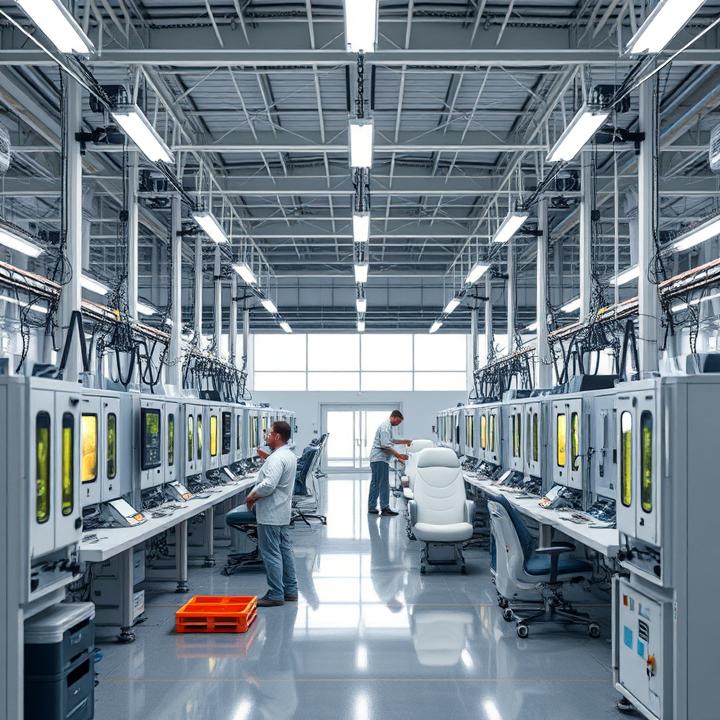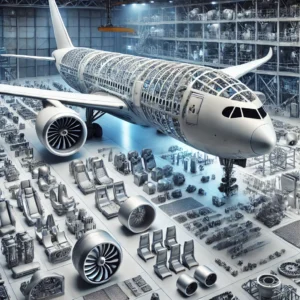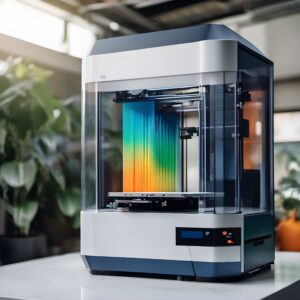
Explore how 3D printing has transformed aerospace production by reducing costs, shortening lead times, and enabling innovative designs. This case study examines key projects and the technology’s potential benefits for industry leaders.
3D Printing’s Impact on Aerospace
Traditional aerospace manufacturing is a highly complex and costly process. With its reliance on precision engineering, specialized materials, and intricate assembly techniques, aerospace production has long been associated with high costs and long lead times. The traditional methods of making aerospace components often require multiple processes, from casting to machining, and typically involve significant waste and high material consumption. Additionally, aerospace companies must stock large inventories of spare parts, each requiring careful management, storage, and transportation, further inflating costs.
However, the advent of 3D printing (also known as additive manufacturing) has begun to change the landscape of aerospace manufacturing. This transformative technology has brought about several benefits, including the reduction of material waste, cost savings on production, and the ability to produce complex parts that were once too expensive or impractical to create using traditional manufacturing techniques. By building parts layer by layer, 3D printing uses only the material necessary for creating a component, leading to less waste and more sustainable manufacturing practices.
In the aerospace industry, where high-performance components often require intricate geometries and advanced materials, 3D printing offers a significant advantage. Aerospace companies are adopting this technology at an increasing pace, recognizing the opportunities for cost savings, faster production cycles, and greater design flexibility. Through this case study, we will explore how industry leaders like GE Aviation, Boeing, and NASA have leveraged 3D printing to reduce production costs and enhance their manufacturing capabilities.
Case Examples: GE, Boeing, and NASA’s Adoption of 3D Printing
GE Aviation: The LEAP Fuel Nozzle
One of the most widely cited examples of 3D printing’s impact on aerospace manufacturing is GE Aviation’s use of additive manufacturing to create the LEAP fuel nozzle, which is used in their LEAP engine series. This nozzle is a key component of the engine’s fuel system and is designed to precisely deliver fuel for efficient combustion. Traditionally, this nozzle would have been made from several individual components, requiring extensive machining and welding.
By employing 3D printing, GE was able to consolidate the fuel nozzle into a single, complex part. This part, made from a heat-resistant alloy, is significantly lighter and more durable than its traditionally manufactured counterparts. GE used a metal 3D printing process known as selective laser melting (SLM), which allows for precise control over material properties. This not only reduced the number of parts that needed to be assembled but also helped to eliminate welding, a costly and labor-intensive process.
The use of 3D printing also led to significant cost savings. The LEAP nozzle is lighter, weighing approximately 25% less than previous versions, contributing to improved fuel efficiency in the aircraft. The reduction in part count not only saves on manufacturing time but also leads to significant reductions in both labor costs and materials. Moreover, the process of producing the nozzle via 3D printing takes just a few weeks, a drastic reduction from the traditional months-long production cycle.
In terms of cost, GE has reported that 3D printing helped save approximately $3 million in production costs per engine. The efficiency gains in manufacturing and the reduced weight of the nozzle also contribute to lower operating costs for airlines, as fuel consumption is reduced, providing a compelling case for 3D printing’s role in both production and operational efficiency.
Boeing’s Use of 3D Printing in Structural Components
Boeing, a global leader in aerospace manufacturing, has been a pioneer in integrating 3D printing into its production processes. One notable area where Boeing has utilized additive manufacturing is in the production of structural components for its aircraft. Components such as brackets, ducts, and seat frames, which were traditionally manufactured from materials like aluminum, are now being produced using 3D printing. The company has adopted both metal and plastic 3D printing methods to create lightweight yet durable parts, which contribute to the overall efficiency and performance of their aircraft.
Boeing’s 3D printing efforts have led to significant reductions in both cost and weight. By using 3D printing to produce components with complex geometries, Boeing is able to design parts that would have been impossible or too expensive to create using traditional techniques. For example, in the production of an air duct, Boeing was able to reduce the part count by integrating several components into one, leading to a reduction in assembly time and costs. Moreover, by using lighter materials and advanced design techniques, these components are contributing to the overall reduction in the weight of aircraft, leading to greater fuel efficiency.
A key benefit for Boeing has been the ability to manufacture parts on demand. This is particularly useful for spare parts, which are often needed in emergency situations. 3D printing enables the company to produce parts quickly and cost-effectively, reducing reliance on extensive inventories and cutting down on storage and transportation costs. In the past, sourcing parts for aging aircraft could be a logistical challenge, but with 3D printing, Boeing has made rapid prototyping and small-scale production a reality.
NASA’s Use of 3D Printing for Space Exploration
NASA has also embraced 3D printing as part of its efforts to reduce the costs and logistical challenges of space exploration. Traditional aerospace manufacturing methods require that parts be specially designed and fabricated on Earth, then transported to space, where they are often difficult to replace or repair. This process is expensive and time-consuming, especially for long-duration missions like those planned for Mars.
To address these challenges, NASA has begun using 3D printing for parts on the International Space Station (ISS) and for future missions to the Moon and Mars. The ability to 3D print parts in space allows astronauts to manufacture tools and components on demand, reducing the need to send spare parts from Earth.
One significant project that highlights NASA’s use of 3D printing is the production of rocket engine components. NASA has been using additive manufacturing to print rocket injectors, which are essential components for controlling the flow of fuel and oxidizers into the combustion chamber of a rocket. The use of 3D printing allows for more efficient designs that improve the performance and efficiency of rocket engines, which are critical for future deep-space exploration.
In addition to reducing costs and material waste, NASA’s 3D printing initiatives on the ISS have the potential to revolutionize how space exploration missions are conducted. The ability to print components in space can significantly reduce the need for costly resupply missions, which are a major logistical challenge. Furthermore, the materials and technologies developed for 3D printing in space may pave the way for innovations that could be used in future space habitats or even for colonizing Mars.
Cost Reduction and Production Efficiency Insights
Reduced Material Costs
One of the primary benefits of 3D printing in aerospace manufacturing is the reduction in material waste. In traditional manufacturing, processes like machining, casting, and forging often generate significant material waste as excess material is removed to create the desired part. For example, when machining a metal component, a large portion of the raw material may be discarded, resulting in high material costs and environmental waste.
In contrast, 3D printing uses only the material necessary to create a part, layer by layer. This eliminates excess material waste, allowing aerospace companies to reduce their material costs significantly. Additionally, 3D printing can use advanced materials, such as high-strength alloys, which can be optimized for specific performance characteristics. These materials are often more expensive than traditional materials, but the savings from reduced waste offset the higher initial costs.
For example, GE Aviation’s use of metal 3D printing for the LEAP fuel nozzle not only reduced the number of parts but also resulted in a 25% reduction in material waste compared to traditional manufacturing. The savings in material costs alone contributed to the overall reduction in production costs.
Minimized Inventory and On-Demand Production
Another area where 3D printing provides substantial cost savings is in inventory management. Traditionally, aerospace manufacturers must keep a large stock of spare parts and components to meet customer demand or repair needs. This requires significant investment in storage, transportation, and logistics. Additionally, aerospace manufacturers must ensure that parts are readily available, often leading to overproduction and increased waste.
With 3D printing, aerospace companies can produce parts on demand, eliminating the need to keep large inventories of spare parts. This not only reduces storage costs but also enables faster response times to customer needs. For instance, if a particular part breaks down on an aircraft, 3D printing allows companies to quickly produce a replacement part, minimizing downtime and reducing the cost of unplanned maintenance.
Furthermore, 3D printing allows companies to optimize their supply chains by reducing the need for long-distance transportation of parts. In the past, parts would need to be manufactured in one location and shipped to another, often across continents. By using 3D printing, aerospace companies can produce parts closer to the point of need, reducing transportation costs and lead times.
Shorter Production and Assembly Times
3D printing also reduces production and assembly times. Traditional aerospace manufacturing often requires multiple steps, including casting, machining, and assembly, each of which adds time and cost to the process. With 3D printing, companies can produce complex parts in a single process, eliminating the need for multiple production stages.
For example, Boeing’s use of 3D printing to produce air ducts and brackets has reduced the number of manufacturing steps involved. These components, which would typically require several parts and extensive assembly, can now be made in a single step using 3D printing. This reduction in production steps not only saves time but also lowers labor costs.
Design Flexibility and New Material Options
Design Complexity
One of the most exciting aspects of 3D printing is its ability to produce highly complex and intricate designs. Traditional manufacturing methods are often limited by the capabilities of the machines and tools used, which can only produce parts with relatively simple shapes. In contrast, 3D printing allows designers to create parts with complex geometries that would be impossible or prohibitively expensive to manufacture using traditional methods.
In aerospace, this capability is particularly valuable. Parts such as lightweight brackets, engine components, and fuel nozzles often require intricate internal geometries to achieve the desired performance characteristics. With 3D printing, aerospace manufacturers can create parts with hollow sections, internal channels, and intricate lattice structures that reduce weight while maintaining strength and durability.
For example, NASA has used 3D printing to create rocket engine injectors with complex internal geometries that optimize the flow of fuel and oxidizers. These parts, which would have been impossible to produce with traditional methods, help improve the performance and efficiency of rocket engines.
New Materials for Performance Enhancement
Another area where 3D printing offers significant benefits is in the development of new materials. While traditional aerospace manufacturing relies on a limited selection of materials, 3D printing allows manufacturers to experiment with a wider variety of materials, including high-strength polymers and advanced metal alloys.
These new materials provide several advantages over traditional materials. For example, some high-strength polymers used in 3D printing are lighter than metals but still possess the necessary strength to withstand the stresses of aerospace applications. Metal alloys, such as titanium and Inconel, offer superior heat resistance, strength, and corrosion resistance, making them ideal for high-performance aerospace parts.
Boeing, for instance, uses 3D printing to produce parts from lightweight thermoplastics and advanced metal alloys. These materials not only reduce weight but also offer the necessary performance characteristics required for aerospace applications.
Customization for Specific Applications
3D printing also allows for the customization of parts to meet specific performance requirements. In traditional manufacturing, customization often requires expensive tooling and significant lead times. With 3D printing, however, parts can be designed and produced to meet the exact specifications needed without the need for expensive tooling or modification.
This is particularly valuable in aerospace, where parts may need to be customized to fit specific aircraft or mission requirements. For example, parts like seat frames, ducts, and brackets can be customized to meet the specific design needs of an aircraft, improving overall efficiency and reducing costs associated with mass production.
Future Potential in Aerospace Manufacturing
Expanding Applications Beyond Prototyping
While 3D printing in aerospace is currently being used mainly for prototyping and producing small-scale parts, there is significant potential for it to expand into end-use production. As the technology matures, it is expected that 3D printing will be used more frequently for producing final parts that are used in the operational life of aircraft.
This could lead to significant cost savings, especially as aerospace companies continue to push the boundaries of design and material innovation. The ability to produce end-use parts on demand will further reduce the need for large inventories and long lead times, streamlining the entire supply chain.
Advances in Materials and Printing Technology
As 3D printing technology evolves, so too will the materials and printing methods available for aerospace applications. New, high-strength materials are being developed that offer even better performance characteristics, such as higher heat resistance and greater durability. Additionally, printing speeds and precision are expected to improve, making it even more viable for large-scale production.
Regulatory Considerations and Industry Standards
As the use of 3D printing increases in aerospace, regulatory bodies will need to establish industry standards and certifications for 3D-printed parts. This is already happening in some sectors, but the process is still in its early stages. Standardization will be critical in ensuring the safety and reliability of 3D-printed components, especially as they begin to be used in critical applications like jet engines and spacecraft.
Expert Insights
In conclusion, 3D printing is already having a significant impact on the aerospace industry, reducing production costs, improving efficiency, and enabling innovative designs. Through the examples of GE Aviation, Boeing, and NASA, we can see the tangible benefits of this technology, from material savings to faster production times and enhanced part performance.
As the technology continues to evolve, the potential for 3D printing in aerospace manufacturing is immense. With advancements in materials, printing speeds, and industry standards, the aerospace industry is poised to see even greater cost reductions and performance improvements in the coming years. 3D printing is not just a tool for prototyping anymore—it’s transforming the way aerospace components are made and opening up new possibilities for innovation.




